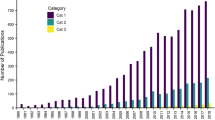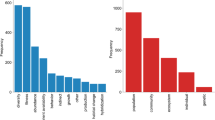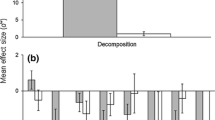Abstract
An increasing number of studies report impacts from invasive species on community metrics or ecosystem functions. We draw attention to an issue arising whenever impact is measured on a community where the invader is an integrated part: should or shouldn’t the attributes of the invader itself be included in the data-analysis? We identify many examples from the published literature showing inconsistency in whether or not data for the invader is included or excluded, and discuss potential implications for ecological interpretations. We also provide a case study to show that the invasive seaweed Undaria pinnatifida can be interpreted to have strong or no impact on seaweed communities, depending on its inclusion or exclusion in the data analysis. We conclude that it is critical for studies to (1) clearly state in the methods section, if the invaders are included or excluded from the data-analysis, (2) acknowledge potential differences in outcomes when comparing results based on different methods, and (3) analyze, if possible, impacts both with and without the invader. Finally, we note that this ‘inclusion versus exclusion’ conundrum is not only relevant to invasion biology, but to any field where the test-object of interest can be an integrated part of the response, such as when impact of seaweed blooms are analysed on community productivity or community effects are quantified over time from ecological pulse-perturbation experiments.




Similar content being viewed by others
References
Aguilera AG, Alpert P, Dukes JS et al (2010) Impacts of the invasive plant Fallopia japonica (Houtt.) on plant communities and ecosystem processes. Biol Invasions 12:1243–1252
Albins M (2013) Effects of invasive Pacific red lionfish Pterois volitans versus a native predator on Bahamian coral-reef fish communities. Biol Invasions 15:29–43
Anderson MJ, Gorley RN, Clarke KR (2008) PERMANOVA for PRIMER: guide to software and statistical methods. PRIMER-E Ltd., Plymouth
Andreu J, Manzano-Piedras E, Bartomeus I et al (2010) Vegetation response after removal of the invasive Carpobrotus hybrid complex in Andalucía, Spain. Ecol Restor 28:440–448
Angeloni NL, Jankowski KJ, Tuchman NC et al (2006) Effects of an invasive cattail species (Typha × glauca) on sediment nitrogen and microbial community composition in a freshwater wetland. FEMS Microbiol Lett 263:86–92
Balata D, Piazzi L, Cinelli F (2004) A comparison among assemblages in areas invaded by Caulerpa taxifolia and C. racemosa on a subtidal Mediterranean rocky bottom. Mar Ecol-Pubbl Della Stn Zool Napoli I 25:1–13
Bender EA, Case TJ, Gilpin ME (1984) Perturbation experiments in community ecology: theory and practice. Ecology 65:1–13
Blum JC, Chang AL, Liljesthrom M et al (2007) The non-native solitary ascidian Ciona intestinalis (L.) depresses species richness. J Exp Mar Biol Ecol 342:5–14
Cacabelos E, Engelen AH, Mejia A et al (2012) Comparison of the assemblage functioning of estuary systems dominated by the seagrass Nanozostera noltii versus the invasive drift seaweed Gracilaria vermiculophylla. J Sea Res 72:99–105
Christian JM, Wilson SD (1999) Long-term ecosystem impacts of an introduced grass in the northern Great Plains. Ecology 80:2397–2407
Clarke KR, Warwick RM (1994) Change in marine communities—an approach to statistical analysis and interpretation. Plymouth Marine Laboratory, Plymouth, p 144
Clarke PJ, Latz PK, Albrecht DE (2005) Long-term changes in semi-arid vegetation: invasion of an exotic perennial grass has larger effects than rainfall variability. J Veg Sci 16:237–248
Cléments DR, Weise SF, Swanton CJ (1994) Integrated weed management and weed species diversity. Phytoprotection 75:1–18
Corzo A, Van Bergeijk S, Garcia-Robledo E (2009) Effects of green macroalgal blooms on intertidal sediments: net metabolism and carbon and nitrogen contents. Mar Ecol Prog Ser 380:81–93
Cushman JH, Gaffney KA (2010) Community-level consequences of invasion: impacts of exotic clonal plants on riparian vegetation. Biol Invasions 12:2765–2776
Dalsgaard T (2003) Benthic primary production and nutrient cycling in sediments with benthic microalgae and transient accumulation of macroalgae. Limnol Oceanogr 48:2138–2150
Flory SL, Clay K (2009) Invasive plant removal method determines native plant community responses. J Appl Ecol 46:434–442
Forrest BM, Taylor MD (2003) Assessing invasion impact: survey design considerations and implications for management of an invasive marine plant. Biol Invasions 4:375–386
Glasby T, Underwood A (1996) Sampling to differentiate between pulse and press perturbations. Environ Monit Assess 42:241–252
Grey MJ, Clarke MF, Loyn RH (1998) Influence of the Noisy Miner Manorina melanocephala on avian diversity and abundance in remnant Grey Box woodland. Pac Conserv Biol 4:55–69
Harries DB, Harrow S, Wilson JR et al (2007) The establishment of the invasive alga Sargassum muticum on the west coast of Scotland: a preliminary assessment of community effects. J Mar Biol Assoc UK 87:1057–1067
Hejda M, Pyšek P (2006) What is the impact of impatiens glandulifera on species diversity of invaded riparian vegetation? Biol Conserv 132:143–152
Hurlbert SH (1984) Pseudoreplication and the design of ecological field experiments. Ecol Monogr 54:187–211
Klein JC, Verlaque M (2011) Experimental removal of the invasive Caulerpa racemosa triggers partial assemblage recovery. J Mar Biol Assoc UK 91:117–125
Lang AC, Buschbaum C (2010) Facilitative effects of introduced Pacific oysters on native macroalgae are limited by a secondary invader, the seaweed Sargassum muticum. J Sea Res 63:119–128
Lowe S, Browne M, Boudjelas S et al (2000) 100 of the world’s worst invasive alien species: a selection from the global invasive species database. Invasive Species Specialist Group Auckland, New Zealand
Maggi E, Benedetti-Cecchi L, Castelli A et al (2015) Ecological impacts of invading seaweeds: a meta-analysis of their effects at different trophic levels. Divers Distrib 21:1–12
Morrison G (2002) Wetland vegetation before and after experimental loosestrife removal. Wetlands 22:159–169
Olden J, Kennard MJ, Pusey BJ (2008) Species invasions and the changing biogeography of Australian freshwater fishes. Glob Ecol Biogeogr 17:25–37
Piazzi L, Ceccherelli G (2006) Persistence of biological invasion effects: recovery of macroalgal assemblages after removal of Caulerpa racemosa var. cylindracea. Estuar Coast Shelf Sci 68:455–461
Powell KI, Chase JM, Knight TM (2011) A synthesis of plant invasion effects on biodiversity across spatial scales. Am J Bot 98:539–548
Qu W, Morrison R, West R (2003) Inorganic nutrient and oxygen fluxes across the sediment–water interface in the inshore macrophyte areas of a shallow estuary (Lake Illawarra, Australia). Hydrobiologia 492:119–127
Sánchez I, Fernández C (2005) Impact of the invasive seaweed Sargassum muticum (Phaeophyta) on an intertidal macroalgal assemblage. J Phycol 41:923–930
Scharfy D, Eggenschwiler H, Olde Venterink H et al (2009) The invasive alien plant species Solidago gigantea alters ecosystem properties across habitats with differing fertility. J Veg Sci 20:1072–1085
Schooler SS, McEvoy PB, Coombs EM (2006) Negative per capita effects of purple loosestrife and reed canary grass on plant diversity of wetland communities. Divers Distrib 12:351–363
Schreiber ESG, Lake PS, Quinn GP (2002) Facilitation of native stream fauna by an invading species? Experimental investigation of the interaction of the snail, Potamopyrgus antipodarum (Hydrobiidae) with native benthic fauna. Biol Invasions 4:317–325
Smith JR, Vogt SC, Creedon F et al (2014) The non-native turf-forming alga Caulacanthus ustulatus displaces space-occupants but increases diversity. Biol Invasions 16:2195–2208
Sol D, Vila M, Kuhn I (2008) The comparative analysis of historical alien introductions. Biol Invasions 10:1119–1129
South PM, Lilley S, Tait LW et al (2016) Transient effects of an invasive kelp on the community structure and primary productivity of an intertidal assemblage. Mar Freshw Res 67:103–112
Staehr PA, Pedersen MF, Thomsen MS et al (2000) Invasion of Sargassum muticum in Limfjorden (Denmark) and its possible impact on the indigenous macroalgal community. Mar Ecol Prog Ser 207:79–88
Stiers I, Crohain N, Josens G et al (2011) Impact of three aquatic invasive species on native plants and macroinvertebrates in temperate ponds. Biol Invasions 13:2715–2726
Sundbäck K, Carlson L, Nilsson C et al (1996) Response of benthic microbial mats to drifting green algal mats. Aquat Microb Ecol 10:195–208
Thomsen MS, Wernberg T, Altieri AH et al (2010) Habitat cascades: the conceptual context and global relevance of facilitation cascades via habitat formation and modification. Integr Comp Biol 50:158–175
Thomsen MS, Byers JE, Schiel DR et al (2014) Impacts of marine invaders on biodiversity depend on trophic position and functional similarity. Mar Ecol Prog Ser 495:39–47
Thomsen MS, Wernberg T, Schiel DR (2015) Invasions by non-indigenous species. In: Crowe TP, Frid CLJ (eds) Marine ecosystems: human impacts on biodiversity, functioning and services. Cambridge University Press, Cambridge, pp 274–332
Truscott AM, Palmer SC, Soulsby C et al (2008) Consequences of invasion by the alien plant Mimulus guttatus on the-species composition and soil properties of riparian plant communities in Scotland. Perspect Plant Ecol Evol Syst 10:231–240
Vilà M, Espinar JL, Hejda M et al (2011) Ecological impacts of invasive alien plants: a meta-analysis of their effects on species, communities and ecosystems. Ecol Lett 14:702–708
Werner S, Rothhaupt KO (2007) Effects of the invasive bivalve Corbicula fluminea on settling juveniles and other benthic taxa. J N Am Benthol Soc 26:673–680
Acknowledgments
M.S.T. was supported by the Marsden Fund Council from Government funding, administered by the Royal Society of New Zealand. T.W. was supported by the Australian Research Council (FT110100174).
Author information
Authors and Affiliations
Corresponding author
Rights and permissions
About this article
Cite this article
Thomsen, M.S., Wernberg, T., South, P.M. et al. To include or not to include (the invader in community analyses)? That is the question. Biol Invasions 18, 1515–1521 (2016). https://doi.org/10.1007/s10530-016-1102-9
Received:
Accepted:
Published:
Issue Date:
DOI: https://doi.org/10.1007/s10530-016-1102-9




